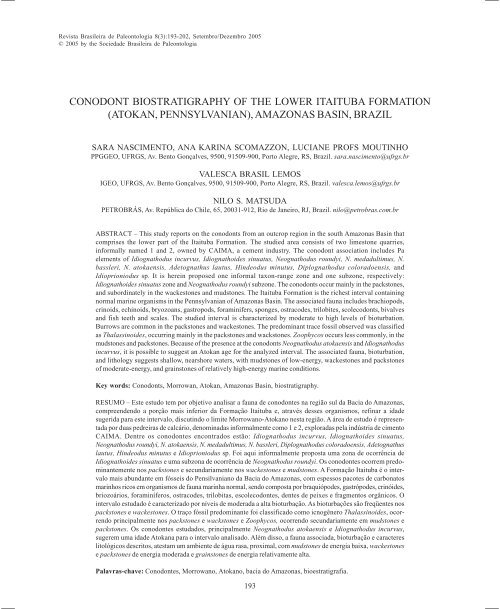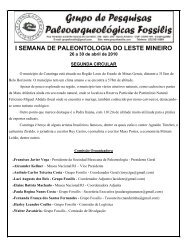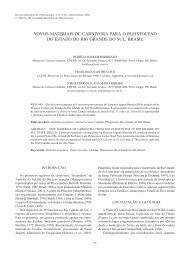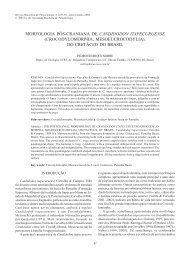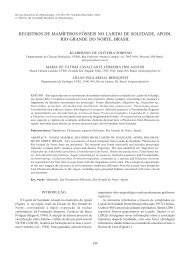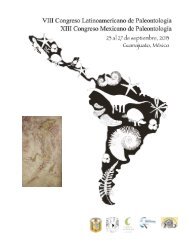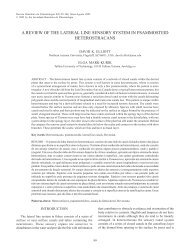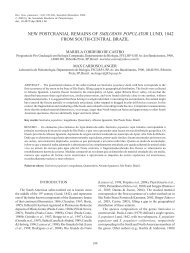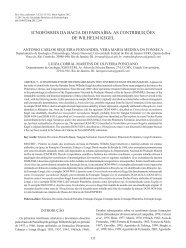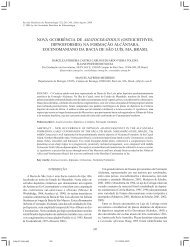conodont biostratigraphy of the lower itaituba formation
conodont biostratigraphy of the lower itaituba formation
conodont biostratigraphy of the lower itaituba formation
Create successful ePaper yourself
Turn your PDF publications into a flip-book with our unique Google optimized e-Paper software.
NASCIMENTO ET AL. – CONODONT BIOSTRATIGRAPHY OF THE ITAITUBA FORMATION197Figure 2. Conodonts from Itaituba Formation, all hypotypes in oral (A-F,H) and lateral (G,I-M) views. A, Idiognathodus incurvus Dunn, P230C2, MP-M-661; B, Idiognathoides sinuatus (Harris & Hollingsworth), P2 160 C10, MP-M-680; C, Idiognathodus incurvus Dunn, P2 160 C10,MP-M-648; D-E, Neognathodus roundyi (Gunnell), P2 30 C2: D, MP-M-700; E, MP-M-676; F, Idiognathodus incurvus Dunn, P2 30C2, MP-M-699; G, Idioprioniodus sp. (Gunnell), P2 430 C9b, MP-M-701; H, Neognathodus roundyi (Gunnell), P2 30 C2, MP-M-702; I, Hindeodus minutus(Ellison), P2 30 C2, MP-M-685; J, Adetognathus lautus (Gunnell), P1 925 C 19, MP-M-703; K-L, Diplognathodus coloradoensis (Murray &Chronic), P1 925 C 19: K, MP-M-688; L, MP-M-687; M, Hindeodus minutus (Ellison), P1 925 C 19, MP-M-704. Scale bar = 100 µm.
198REVISTA BRASILEIRA DE PALEONTOLOGIA, 8(3), 2005Table 1. Conodont distribution in quarry 1.interval analyzed. These environments are mainlycharacterized by differences in water energy, depth,consistency <strong>of</strong> <strong>the</strong> substrate and faunal composition.Supratidal environmentRepresented by recrystalized mudstones <strong>of</strong> lowenergy, originally from micritic muds and frequentlyshowing detrital quartz and evidence <strong>of</strong> subaerialexposure, characterized by dissication cracks anddissolution features with anhydrite and gypsum.Bioclasts are rare and represented by sparse fragments<strong>of</strong> fibrous brachiopods, ostracodes and trilobites.Dolomitization was intense.Intertidal environmentRepresented by moderate to high energy grainstones.Peloidal Grainstone are composed <strong>of</strong> pellets, crinoids andfusulinacean foraminifers. This micr<strong>of</strong>acies characterizesmoderate energy conditions. Bioclastic grainstones arecomposed <strong>of</strong> fragmented organisms such fibrousbrachiopods, bryozoans, foraminifers, ostracodes,trilobites, crinoids and echinoids; sparse ooids and pelletscan be found. Bioturbation and sparry cement are commonfeatures. This micr<strong>of</strong>acies characterizes high energyconditions. Oolitic grainstones are composed <strong>of</strong> nonskeletal,allochthonous components, generally quartzgrains with micritic envelopes. Sparry cement is commonlypresent. Rare oncoids with crinoidal nuclei and pellets canbe found, and bioturbation is common. These micr<strong>of</strong>aciescharacterize high energy conditions.Subtidal environmentRepresented by bioclastic wackestones andpackstones. These micr<strong>of</strong>acies represent normal marinebottom conditions and are composed <strong>of</strong> bioclasts froma normal marine fauna. Mudstones with gastropodscorrespond to a restricted micr<strong>of</strong>acies and is composed<strong>of</strong> bioclasts <strong>of</strong> gastropods floating in a micritic matrix.Secondarily ostracodes, foraminifers, brachiopods andcrinoids are present. Bioclasts do not show preferentialorientation. This micr<strong>of</strong>acies suggests a muddy lowenergy depositional environment, probably in a backshoal. Bioclastic wackestones are composed <strong>of</strong> bioclastsfrom normal marine fauna, such as fibrous and prismaticbrachiopods, crinoids, echinoids, bivalves, bryozoans,foraminifers, trilobites and ostracodes. Bioturbation iscommon. Bioclastic packstones are <strong>the</strong> most commontexture <strong>of</strong> <strong>the</strong> carbonates deposited during <strong>the</strong>Pennsylvanian in <strong>the</strong> Amazonas Basin. The bioclasticconstituents represent a normal marine fauna, includingbrachiopods, crinoids, echinoids, bivalves, bryozoans,foraminifers, trilobites and ostracodes. Bioturbation iscommon. The orientation <strong>of</strong> <strong>the</strong> bioclasts suggests that<strong>the</strong>se sediments were deposited in settings affected bynormal waves, under some energetic conditions, butinsufficient to remove <strong>the</strong> matrix, which suggests asubtidal environment.The <strong>conodont</strong>sThe <strong>conodont</strong> fauna characterized by Idiognathodus,Idiognathoides and Neognathodus occurs widely in bothquarries in <strong>the</strong> bioclastic packstones <strong>of</strong> <strong>the</strong> subtidalenvironment.Davis & Webster (1985) studied bi<strong>of</strong>acies representedby Idiognathodus, Idiognathoides andDeclinognathodus, and suggested that <strong>the</strong>se <strong>conodont</strong>srepresent shallow marine, subtidal deposits with muddysubstracte, low to moderate energy and normal salinity.Neognathodus bi<strong>of</strong>acies generally represent lagoondeposits characterized by calcareous mudstones andcommon co-occurrence with Adetognathus or withIdiognathodus in shallow waters. Adetognathus bi<strong>of</strong>aciestypically represent more shallow waters <strong>of</strong> intertidal tolagoon deposits, characterized by moderate to highenergy and high salinity conditions.According to Dunn (1976), Diplognathoduscoloradoensis is usually common in shallow marinewaters, with relatively high energy conditions. Elements<strong>of</strong> D. coloradoensis were found in only one level <strong>of</strong>quarry 1, associated with Adetognathus lautus.In quarry 1, <strong>the</strong> predominant occurrence <strong>of</strong> bioclasticpackstones and Idiognathodus and Idiognathoidessuggest an environment <strong>of</strong> shallow waters with low tomoderate energy, which grades to more shallow andmoderate to high energy in <strong>the</strong> <strong>lower</strong> part <strong>of</strong> quarry 2
NASCIMENTO ET AL. – CONODONT BIOSTRATIGRAPHY OF THE ITAITUBA FORMATION199with <strong>the</strong> presence <strong>of</strong> Neognathodus associated withAdetognathus. The presence <strong>of</strong> Idiognathodus andIdiognathoides through <strong>the</strong> <strong>lower</strong> to upper levels <strong>of</strong> <strong>the</strong>quarry 2 suggests a return <strong>of</strong> shallow water with low tomoderate energy conditions.According to some authors (Merrill & von Bitter, 1976)Figure 3. Stratigraphic pr<strong>of</strong>iles <strong>of</strong> <strong>the</strong> two quarries (modified from Matsuda, 2003).
200REVISTA BRASILEIRA DE PALEONTOLOGIA, 8(3), 2005Hindeodus and Idioprioniodus are more abundant in deepwaters. Idioprioniodus was rare in <strong>the</strong> basal strata <strong>of</strong>quarry 1, and absent in <strong>the</strong> quarry 2. Hindeodus is alsorare in both quarries, suggesting that <strong>the</strong> studied intervalrepresents shallow waters.Thus, according to field description, facies analyses,environmental characteristics and <strong>conodont</strong> fauna, wesuggest a general transgressive episode through quarry1, grading to a regressive episode in <strong>the</strong> <strong>lower</strong> part <strong>of</strong>quarry 2, which shifted to transgressive deposits through<strong>the</strong> rest <strong>of</strong> quarry 2.The associated faunaThe Itaituba Formation is <strong>the</strong> richest intervalcontaining normal marine organisms in <strong>the</strong> Pennsylvanian<strong>of</strong> Amazonas Basin. The associated fauna in <strong>the</strong> studiedquarries contain brachiopods, crinoids, echinoids,bryozoans, gastropods, foraminifers, sponges,ostracodes, trilobites, scolecodonts, bivalves and teethfish fragments. The brachiopods are <strong>the</strong> most abundantgroup, represented mainly by <strong>the</strong> Productida Order.Secondarily abundant are fish teeth and scales, mainlyactinopterygians <strong>of</strong> <strong>the</strong> Paleonisciforms Order. In <strong>the</strong>studied material specimens <strong>of</strong> <strong>the</strong> Acanthodii andChondrichthyes Classes (identified by Dr. Martha Richter,an expert in fossil fish) were recovered.The associated fauna represents normal marinebottom conditions, with relatively shallow, quiet andwarm waters, and muddy substrate suggesting subtidalenvironmental deposition. The occurrence <strong>of</strong> fragmentedorganic material in <strong>the</strong> <strong>lower</strong> levels <strong>of</strong> quarry 2 (P2 0 C0,P2 10 C1, P2 30 C2 and P2 71 C3/6) suggest possiblereworking by currents and/or bioturbation in moderateenergy conditions. The presence <strong>of</strong> bryozoans, crinoidsand brachiopods indicates good oxygenation andabundance <strong>of</strong> nutrients.The material studied is characterized by moderate to highlevels <strong>of</strong> bioturbation. Burrows are frequent in packstonesand wackestones. The predominant trace fossil observedwas classified as <strong>the</strong> ichnogenus Thalassinoides. TrilobitesTable 2. Conodont distribution in quarry 2.
NASCIMENTO ET AL. – CONODONT BIOSTRATIGRAPHY OF THE ITAITUBA FORMATION201are associated in general with <strong>the</strong> bioturbation <strong>of</strong> <strong>the</strong>sediment, but <strong>the</strong> probable trace-maker was a general shrimplikeanimal, adapted to live in environments with variablelevels <strong>of</strong> oxygenation and salinity. Zoophycos is <strong>the</strong> secondichnogenus described, occurring mainly in mudstones andsecondarily in packstones.According to Doyle et al. (1994), <strong>the</strong> distribution <strong>of</strong>Thalassinoides ranges from intertidal to supratidal, lowto moderate energy, nutrient-rich and dysaerobic settings,while Zoophycos is restricted to subtidal low energy,disaerobic and s<strong>of</strong>t substrate environments.CONCLUSIONSConodonts from <strong>the</strong> two quarries comprising strata<strong>of</strong> <strong>the</strong> <strong>lower</strong> Itaituba Formation, Amazonas Basin, werestudied to refine <strong>the</strong> suggested age <strong>of</strong> this area and tointerpret <strong>the</strong> paleoecological features observed.Conodonts are characterized by Pa elements <strong>of</strong>Idiognathoides sinuatus, Idiognathodus incurvus,Diplognathodus coloradoensis, Hindeodus minutus,Idioprioniodus sp. and Adetognathus lautus in quarry1, and I. sinuatus, I. incurvus, Neognathodus roundyi,N. medadultimus, N. atokaensis, N. bassleri, H. minutusand A. lautus in quarry 2.Idiognathodus, Idiognathoides and Neognathodusare <strong>the</strong> most abundant genera. In <strong>the</strong> carbonates <strong>of</strong> quarry1, Idiognathodus and Idiognathoides are equallyrepresented, followed by rarer Idioprioniodus,Diplognathodus, Hindeodus and Adetognathus.In quarry 2 Idiognathodus and Idiognathoides wererecovered in great abundance, and <strong>the</strong> first appearance<strong>of</strong> Neognathodus is in <strong>the</strong> basal strata <strong>of</strong> this quarry,with N. atokaensis typical <strong>of</strong> Atokan age and N.medadultimus and N. roundyi, typical <strong>of</strong> Atokan-earlyDesmoinesian age. Conodonts were mainly found in <strong>the</strong>packstones and secondarily in wackestones andmudstones.One taxon-range zone and one subzone are informallyproposed: Idiognathoides sinuatus zone, andNeognathodus roundyi subzone. The I. sinuatus zoneextends from <strong>the</strong> <strong>lower</strong> part <strong>of</strong> <strong>the</strong> quarry 1 to <strong>the</strong> upperpart <strong>of</strong> quarry 2, and recognized by <strong>the</strong> local occurrence <strong>of</strong><strong>the</strong> nominate species. The <strong>conodont</strong> fauna comprises <strong>the</strong>index species Idiognathoides sinuatus, Idiognathodusincurvus, Diplognathodus coloradoensis, Idioprioniodussp., Hindeodus minutus and Adetognathus lautus. The N.roundyi subzone is recognized by <strong>the</strong> local occurrence<strong>of</strong> N. roundyi in <strong>the</strong> <strong>lower</strong> part <strong>of</strong> quarry 2. The <strong>conodont</strong>fauna is characterized by N. roundyi, N. medadultimus,N. atokaensis, I. sinuatus, I. incurvus, H. minutus and A.lautus.The Itaituba Formation is <strong>the</strong> richest interval containingnormal marine organisms in <strong>the</strong> Pennsylvanian <strong>of</strong> <strong>the</strong> AmazonasBasin. The associated fauna contains brachiopods,crinoids, echinoids, bryozoans, gastropods, foraminifers,sponges, ostracodes, trilobites, scolecodonts, bivalvesand fish teeth and scales. The presence in both quarries<strong>of</strong> <strong>the</strong> assigned organisms suggests good bottomconditions as warm and clean waters. The <strong>conodont</strong>s,associated fauna and facies analysis suggest relativelyshallow, quiet and warm waters, with muddy substrates ina subtidal setting. At a larger depositional scale, a generaltrangressive-regressive-trangressive episode,characterizes <strong>the</strong>se Atokan age deposits.ACKNOWLEDGMENTSWe are grateful to José Emidio and Paulo Rubens (CAIMACement Ind.) for permitting access to quarry localities. Wethank to Martha Richter (BMNH) for discussion about fossilfish <strong>biostratigraphy</strong> and taxonomy. We also thank <strong>the</strong> support<strong>of</strong> Carlos E. L. Vieira with <strong>the</strong> preparation <strong>of</strong> <strong>the</strong> figures. Wealso appreciate <strong>the</strong> journal editors and <strong>the</strong> reviewers forimprovements to this paper. The research was supported byCNPq-CTPETRO (grant 461082/2000-4).REFERENCESAltiner, D. & Savini, R. 1995. Pennsylvanian foraminifera and<strong>biostratigraphy</strong> <strong>of</strong> <strong>the</strong> Amazonas and Solimões Basin (NorthBrazil). Revue de Paleobiologie, 14(2):417-453.Austin, R.L. 1987. Conodonts: investigative techniques andapplications. Ellis Horwood, 562 p.Cunha, P.R.C.; Gonzaga, F.G.; Coutinho, L.F.C. & Feijó, F.J. 1994.Bacia do Amazonas. Boletim de Geociências da Petrobras,8(1):47-55.Davis, L.E.; Webster, G.D. 1985. Late Mississipian to EarlyPennsylvanian Conodont Bi<strong>of</strong>acies in Central Montana.Lethaia, 18:67-72.Doyle, P.; Bennett, M.R. & Baxter, A.N. 1994. The Key to EarthHistory. 1ª ed. Chichester, John Wiley & Sons, 231 p.Dunn, D.L. 1976. Biostratigraphic problems <strong>of</strong> Morrowan andDerryan (Atokan) strata in <strong>the</strong> Pennsylvanian System <strong>of</strong>western United States. Geological Society <strong>of</strong> America Bulletin,87:641-645.Grayson, R.C. Jr. & Lambert, L.L. 1987. Evolutionary distinctionbetween Atokan and Desmoinesian (Pennsylvanian)Neognathodus. Geological Society <strong>of</strong> America Abstracts withPrograms, 19:152.Lemos, V.B. 1990. Assembléia de Conodontes do Carboníferoda Bacia do Amazonas. Programa de Pós-graduação emGeociências, Universidade Federal do Rio Grande do Sul, Ph.D.Thesis, 259 p.Lemos, V.B. 1992a. Conodontes do Carbonífero das Bacias doAmazonas e Solimões. Taxonomia - Parte I. Pesquisas,19(1):75-93.Lemos, V.B. 1992b. Conodontes do Carbonífero das Bacias doAmazonas e Solimões. Taxonomia - Parte II. Pesquisas,19(2):120-131.Lemos, V.B. & Medeiros, R.A. 1996. O limite Morrowano/Atokanona Bacia do Amazonas, Brasil, com base em <strong>conodont</strong>es. Boletimde Geociências da Petrobras, 10:165-173.Lemos, V.B. & Scomazzon, A.K. 2001. Carboniferousbiochronostratigraphy <strong>of</strong> <strong>the</strong> Amazonas Basin, Brazil, basedon <strong>conodont</strong>s. Ciência Técnica Petróleo, Sec. Exploração dePetróleo, 20:131-138.Manger, W.I. & Su<strong>the</strong>rland, P.K. 1984. Preliminary <strong>conodont</strong>
202REVISTA BRASILEIRA DE PALEONTOLOGIA, 8(3), 2005<strong>biostratigraphy</strong> <strong>of</strong> <strong>the</strong> Morrowan-Atokan boundary(Pennsilvanian), eastern Llano Uplift, central Texas. OklahomaGeological Survey Bulletin, 136:115-122.Matsuda, N.S. 2003. Carbonate sedimentation cycle and origin <strong>of</strong>dolomite in <strong>the</strong> Lower Pennsylvanian intracratonic AmazonBasin, Nor<strong>the</strong>rn Brazil. Department <strong>of</strong> Earth & PlanetarySciences, University <strong>of</strong> Tokyo, Ph.D. Thesis, 231 p.Merrill, G.K. & von Bitter, P.H. 1976. Revision <strong>of</strong> <strong>conodont</strong> bi<strong>of</strong>aciesnomenclature and interpretations <strong>of</strong> envinonmental controls inpennsylvanian rocks <strong>of</strong> eastern and central North America. RoyalOntario Museum, Life Sciences Contributions, 108:1-46.Milani, E.J. & Zalán, P.V. 1998. The geology <strong>of</strong> paleozoic cratonicbasins and mesozoic interior rifts <strong>of</strong> Brazil (Brazilian GeologyPart I). American Association <strong>of</strong> Petroleum Geologists, 184 p.Neis, P.A. 1996. Resultados biocronoestratigráficos das associaçõesde <strong>conodont</strong>es da Formação Itaituba, CarboníferoSuperior (Pensilvaniano), da Bacia do Amazonas. Programade Pós-graduação em Geociências, Universidade Federal doRio Grande do Sul, Master Thesis, 138 p.Playford, G.B. & Dino, R. 2000. Palynostratigraphy <strong>of</strong> upperPalaeozoic strata (Tapajós Group), Amazonas Basin, Brazil:Part one. Palaeontographica Beitrage Zur NaturgeschichteDer Vorzeit, Abt. B. Bd., 255:1-46.Scomazzon, A.K. 1999. Refinamento bioestratigráfico com baseem <strong>conodont</strong>es, Pensilvaniano da Bacia do Amazonas, regiãodo Tapajós. Programa de Pós-graduação em Geociências,Universidade Federal do Rio Grande do Sul, Master Thesis,142 p.Scotese, C. R. & Mckerrow, W. S. 1990. Palaeozoicpalaeogeography and biogeography. Geological SocietyMemoir, 12:1-21.Received April, 2005; accepted September, 2005.


